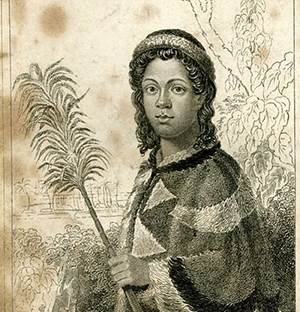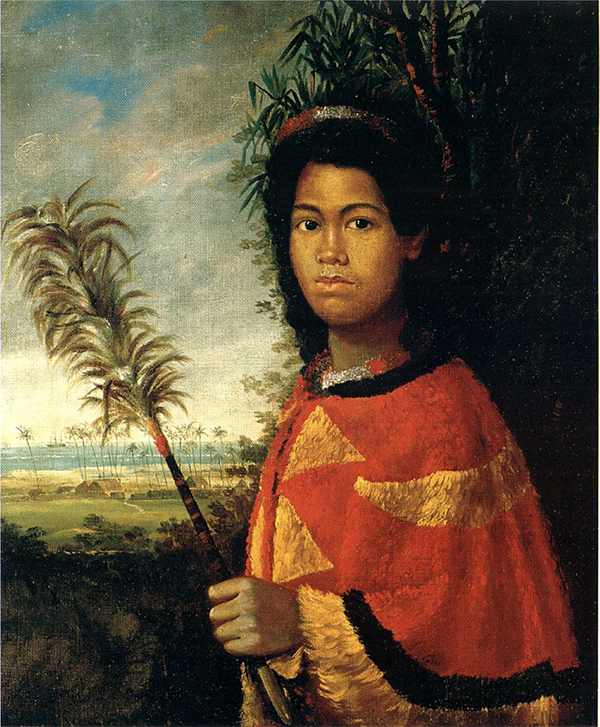Princess Nahi’ena’ena
Princess Nahi’ena’ena

Princess Harrieta Keōpūolani Nāhiʻenaʻena
(No exact date 1815 – December 30, 1836)
Princess Nahi’ena’ena was a high-ranking princess during the founding of the Kingdom of Hawaii and the conversion of some of the ruling class to Christianity.
In the Hawaiian language nā ahi ʻena ʻena means “the red-hot raging fires”
Princess Nahi’ena’ena was born in 1815 at Keauhou Bay, South Kona, island of Hawaiʻi. Her parents were Kamehameha I and Keōpūolani the Queen consort. She had two older brothers, hiapo (first born) Liholiho, and Kauikeaouli, who were to become Kings Kamehameha II and III. This sacred muli loa (last born) child was trained for the immense kuleana (privilege and responsibility) that would accompany someone of such high birth.
In 1825, the ship HMS Blonde returned with the bodies of King Kamehameha II and the Queen Kamāmalu who had died on a trip to London. Ship’s artist Robert Dampier painted a portrait of the ten-year-old princess, dressed in a red feather cloak for the state funeral. (shown above)
Princess Nahi’ena’ena was in love with her brother Kamehameha III and the old chiefs strongly encouraged their marriage, but the missionaries were opposed to the union, calling it incest and therefore a sin. The practice of marriage between siblings in the royal family was considered a way of keeping the bloodlines pure in ancient Hawaii. Nāhiʻenaʻena’s own maternal grandparents were half sister and brother.
Princess Nāhiʻenaʻena had been affected by the conflicts of Christianity and her culture causing her to embrace both beliefs. She would follow cultural traditions such as Hula, but also drink rum just as the missionaries did. She showed rebellion and distaste for many Christian tasks. She would interrupt church services and openly defy missionary teachings. Although she and many others were fragmented on beliefs, she never fully converted. She may have been fighting to stay embedded with her Hawaiian culture.
She was eventually betrothed to William Pitt Leleiohoku I, the son of William Pitt Kalanimoku Prime Minister of Hawaii. Kamehameha III tried to delay the wedding by insisting Leleiohoku be educated first. Leleiohoku and Nāhiʻenaʻena were married November 25, 1835 by William Richards at Waineʻe Church.
In September 17, 1836 she gave birth to a child. Kamehameha III announced that the child would be the heir to the throne because he believed it to be his, but the child lived for only a few hours. Nāhiʻenaʻena never recovered physically or emotionally from the birth of her child. British physician Thomas Charles Byde Rooke, the husband of High Chiefess Grace Kamaʻikuʻi, examined her but was unable to determine the cause of the illness. He called upon Dr. Ruschenberger, a visiting surgeon, to assist him. On her death bead, missionary wives tried to urge her to repent for her sins. Nāhiʻenaʻena died on December 30, 1836(1836-12-30), near Hale Uluhe, the home of her brother, Kamehameha III. After nearly five weeks of intense grieving, her body was brought in procession to Kawaiahaʻo Church for funeral services. The procession was led by traditional warriors and kāhuna laʻau lapaʻau (healers). On April 12, 1837 her body was brought aboard the ship Don Qixote (purchased and renamed Kai Keōpūolani by her brother), to the sacred resting place called Mokuʻula in Lāhainā, Maui to be buried next to her mother Keōpūolani.
Follow us
Join Our Community
Follow us on Facebook
Follow Us on Instagram

Daughters of the Goddess on Paypal
Use for Rituals, Workshops,
Zoom Sessions and Purchases.

